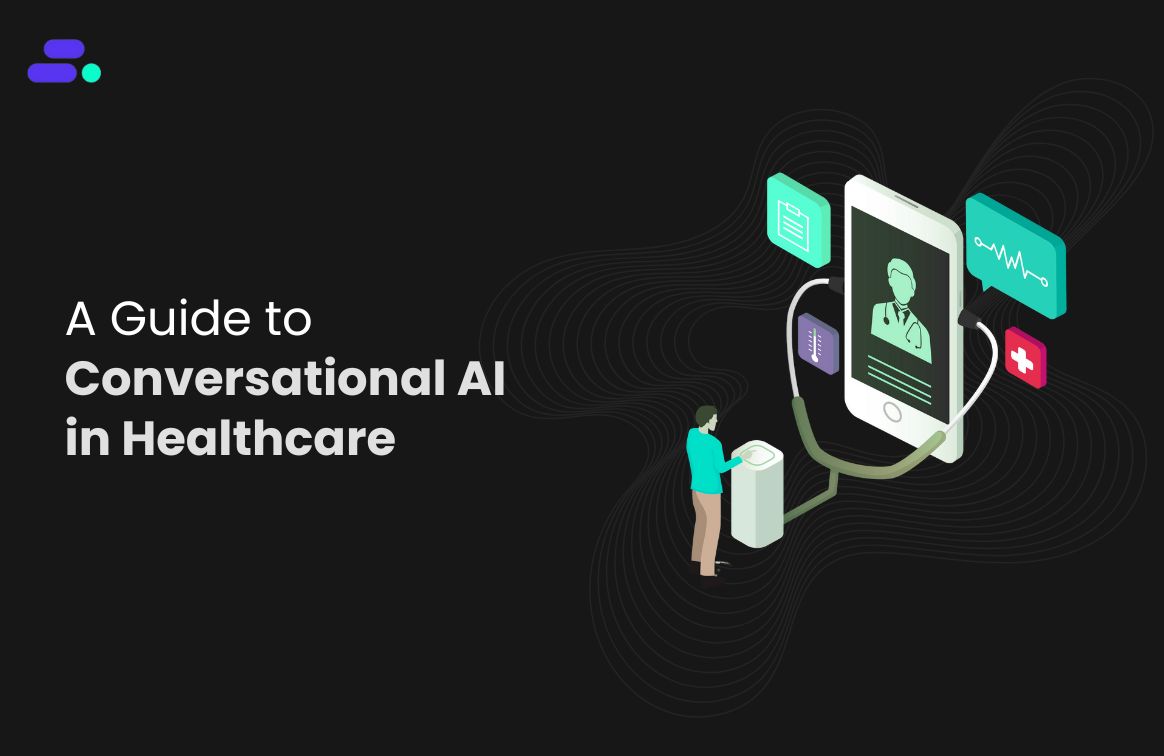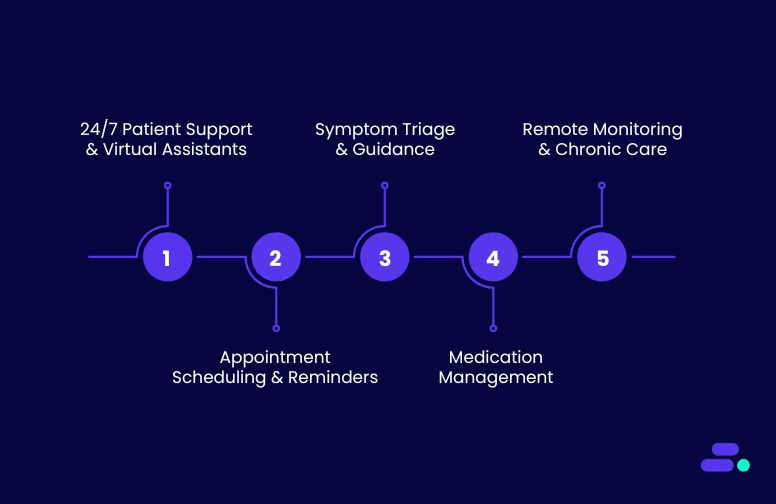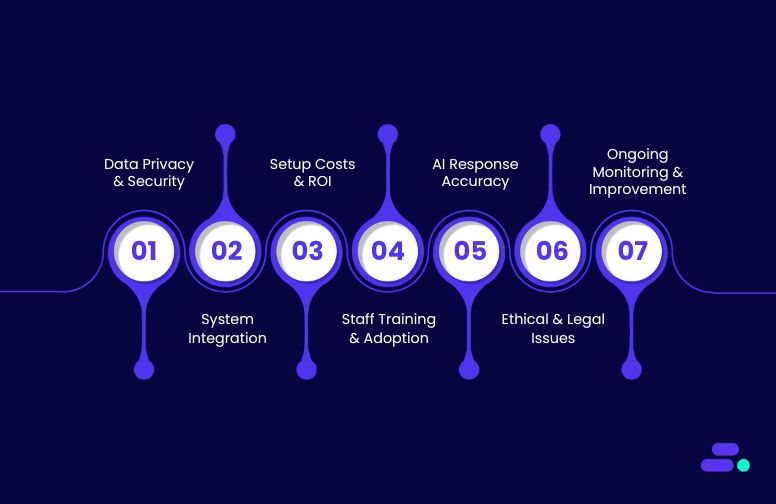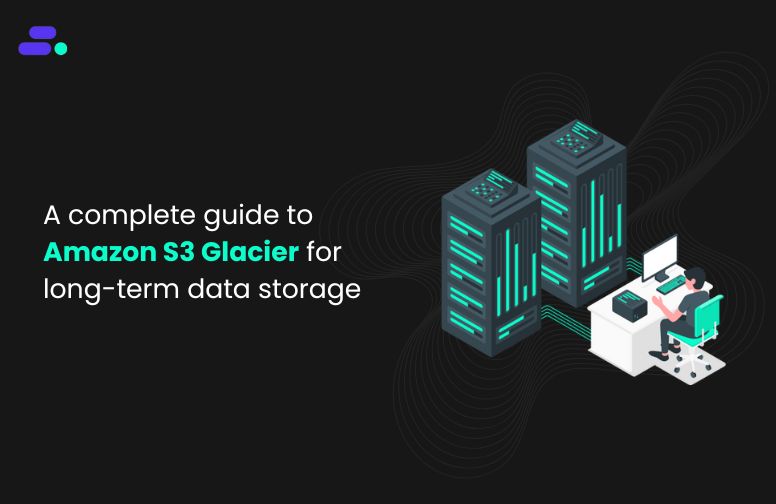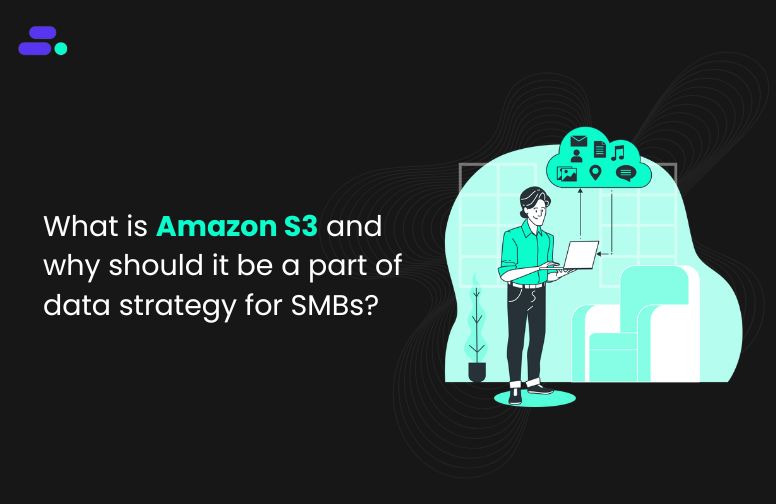This is a div block with a Webflow interaction that will be triggered when the heading is in the view.

Modernize your cloud. Maximize business impact.
A regional logistics company migrates its order tracking system to the cloud hoping for quick gains, including faster performance, easier scaling, and lower IT overhead. But six months in, the benefits feel unclear. Some costs go down, others pop up. Teams are still adapting. This might be a true story for many small and mid-sized businesses (SMBs) today.
Cloud migration is a strategic move but the return on that investment (ROI) doesn’t always show up in a straight line. Year one can feel like a balancing act between early wins and foundational setup. That’s normal, but there is a pattern to what works. When done right, SMBs can see meaningful returns like faster deployments, reduced licensing costs, and less time spent firefighting infrastructure issues.
This guide looks at where SMBs typically see ROI within the first 12 months of cloud migration, and what factors move the needle.
Key takeaways:
- The most valuable returns come from improved efficiency, faster product delivery, and better data insights, not just lower infrastructure costs.
- By months 3 to 6, many SMBs see reduced overhead and improved visibility. Value comes from automation, analytics, and operational agility by month 12.
- Services like AWS Athena, Lambda, and Trusted Advisor can significantly enhance performance, reduce waste, and support data-driven decisions.
- SMBs that monitor cost trends, resource usage, and team output using tools like Cost Explorer and CloudWatch are better positioned to optimize and grow.
- Cloudtech helps SMBs avoid common migration issues by delivering clear roadmaps, cost governance, and AWS-aligned architecture.
Why does ROI clarity matter for SMBs?
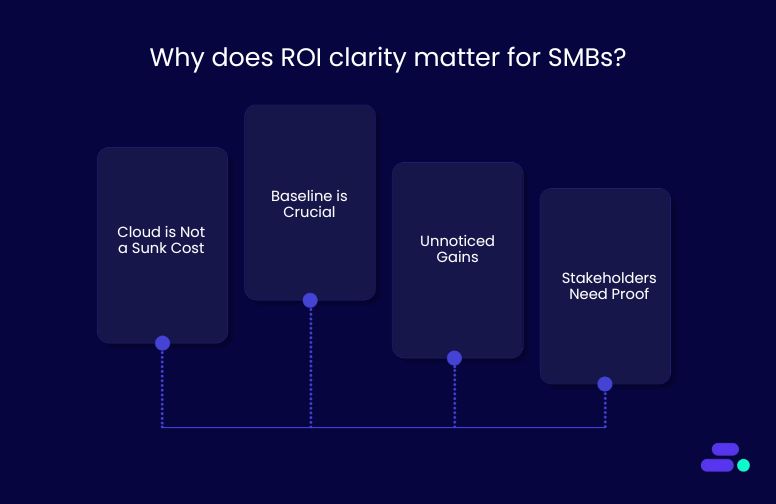
Cloud migration is a strategic investment. But unlike one-time infrastructure purchases, the ROI isn’t always immediately clear. Many SMBs move to the cloud with the expectation of faster performance, lower costs, or better scalability, only to find it hard to prove those benefits internally.
Without a clear framework for tracking ROI, it becomes difficult to validate the effort, justify future investments, or pinpoint what’s working and what’s not.
Here’s why getting ROI clarity in year one matters:
- Cloud is not a sunk cost: Businesses are not just spending on infrastructure. They’re investing in agility, security, and long-term growth. ROI should reflect operational impact, not just technical metrics.
- Having a baseline is important: Many teams skip defining clear pre-migration metrics (e.g., downtime hours, support tickets, time-to-deploy), which makes it harder to compare gains post-migration.
- Untracked gains often go unnoticed: Savings in developer time, faster release cycles, reduced maintenance overhead, or uptime improvements are real but easily overlooked without intentional tracking.
- Stakeholders need proof: For SMB leaders managing tight budgets, ROI clarity builds confidence, aligns teams, and strengthens the case for ongoing modernization.
With the right tools and tracking in place, the first 12 months post-migration can provide a clear picture of value delivered, setting the stage for even greater returns in year two and beyond.

Where does cloud ROI come from and how to measure it?
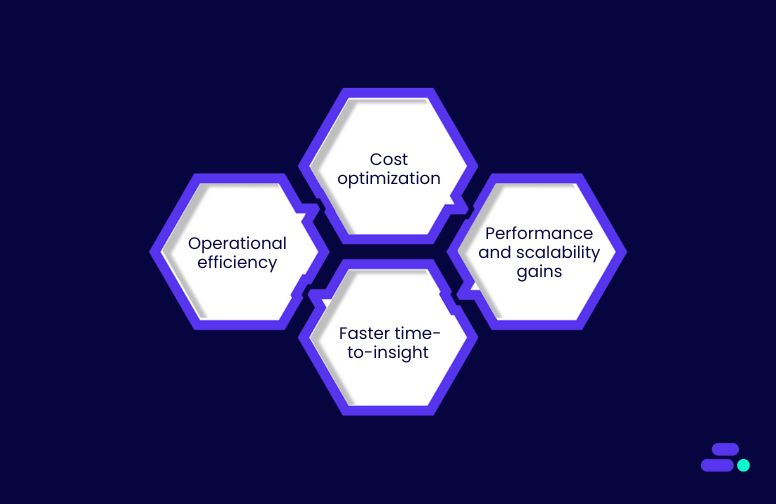
For SMBs, the return on cloud investment shows up across four key areas, each measurable with the right AWS tools and tracking discipline. Clarity here helps teams identify what’s working, justify costs, and optimize faster.
1. Operational efficiency
Cloud-native services reduce the overhead of managing infrastructure, freeing up teams to focus on innovation instead of maintenance.
- CI/CD pipelines deployed via AWS CodePipeline or GitHub Actions allow faster, automated deployments, cutting release times from days to minutes.
- Serverless architectures (like AWS Lambda and Step Functions) simplify backend logic, eliminating the need to manage EC2-based app servers.
Example: A healthcare SMB replaces batch-based reporting with AWS Athena queries on Amazon S3 data, reducing patient analytics turnaround from hours to minutes.
2. Cost optimization
Cloud spending is dynamic, but with visibility and good architecture, SMBs can reduce waste and shift from fixed costs to pay-as-you-go models.
- Auto-scaling groups and EC2 Spot Instances help scale workloads efficiently, especially for dev/test or stateless jobs.
- AWS Lambda and Fargate remove the need to pay for idle compute.
- Use AWS Cost Explorer to visualize spend trends, and AWS Compute Optimizer to right-size EC2 and EBS resources.
- OpEx flexibility also helps SMBs avoid large CapEx purchases, improving cash flow and budget agility.
3. Performance and scalability gains
Unlike on-prem hardware, cloud enables SMBs to scale based on demand, not prediction.
- Elastic Load Balancing and Auto Scaling allow web apps to handle spikes without degraded performance.
- Amazon CloudFront improves global latency with edge caching.
- Multi-AZ deployments and Amazon RDS read replicas ensure availability and responsiveness at scale.
4. Faster time-to-insight
SMBs using AWS data services gain quicker access to decision-making.
- Amazon Athena enables SQL queries directly on Amazon S3, removing the need for traditional ETL pipelines.
- Amazon Redshift provides high-performance analytics for structured data warehouses.
- QuickSight helps visualize these insights, making dashboards accessible even to non-technical users.
Bottom line: AWS provides both the tools and architecture patterns to quantify cloud ROI across performance, cost, and time. SMBs that align their goals with these levers tend to see measurable returns within the first 12 months.
Sample ROI metrics to track:

What realistic ROI looks like in the first year?
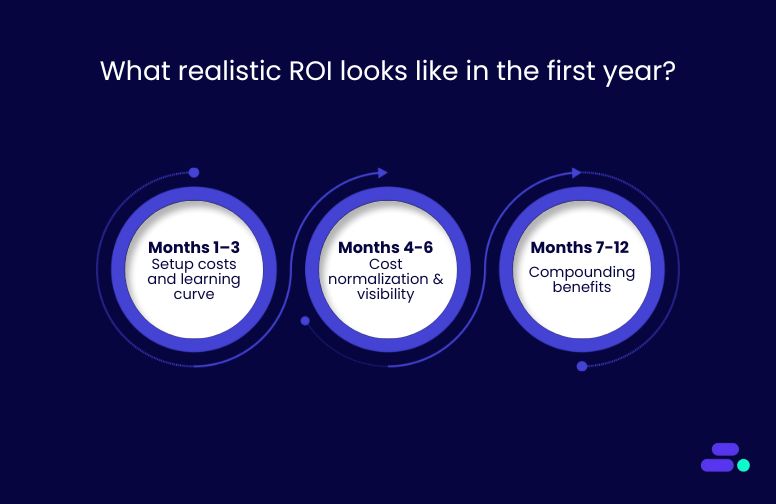
SMBs entering the cloud face pressure to show ROI quickly, but it’s important to understand how value unfolds across the first 12 months. Returns aren’t always immediate, but with the right AWS tools and governance, compounding gains emerge in automation, agility, and insight.
Months 1–3: Setup costs and learning curve
The first phase of cloud migration is often the most resource-intensive, as SMBs lay the groundwork for long-term value. Costs during this period span not just infrastructure, but skills development, governance setup, and workload re-architecture.
Initial investment areas:
- Training and enablement: Teams require upskilling in cloud-native concepts like shared responsibility, identity and access control, and serverless computing. Training platforms (e.g., AWS Skill Builder or third-party labs) help close skill gaps.
- Discovery and planning tools: Tools like AWS Application Discovery Service or Migration Evaluator are used to inventory existing systems, map interdependencies, and assess readiness. This reduces rework later by avoiding overlooked components during migration.
Foundational architecture work:
- Environment setup: Organizations establish core services like cloud networking (VPCs, subnets, NAT gateways), IAM roles and policies, and S3 buckets for backup and storage. Multi-account strategies are often implemented using AWS Organizations or Control Tower.
- Workload replatforming or rehosting: Teams begin lifting and shifting VMs to cloud compute (e.g., Amazon EC2 or Lightsail), or refactor apps to use managed services like Amazon RDS (for databases), Amazon ECS/Fargate (for containers), or AWS Lambda (for serverless).
Early wins and quick reductions:
- Retiring physical infrastructure reduces power, cooling, maintenance, and hardware refresh cycles. SMBs can decommission old on-prem file servers and run scalable file shares using Amazon FSx or EFS.
- Replacing manual processes with cloud-native operations. AWS Backup automates snapshot management. Amazon CloudWatch enables centralized logging and alarms. IAM roles replace legacy credential-sharing and manual access control.
While costs may initially rise due to training, dual-running infrastructure, or consulting engagements, this period builds the foundation for long-term efficiency, observability, and agility, especially when SMBs take advantage of AWS’s modular, pay-as-you-go model.
Months 4–6: Cost normalization and visibility
As SMBs move beyond initial setup, the cloud environment begins to stabilize, making it easier to understand actual usage, identify inefficiencies, and align spend with business value. This stage is all about turning raw cloud usage into actionable insights.
Visibility tools:
- AWS Cost Explorer: Visualizes cost and usage data by service, linked account, or custom tags (e.g., team, workload, environment). It helps SMBs detect unexpected cost spikes and analyze trends.
- AWS Budgets: Enables teams to define budget thresholds and receive alerts when usage exceeds targets. SMBs can set monthly or service-specific budgets to keep teams accountable.
- AWS Trusted Advisor: Performs real-time checks across cost, performance, fault tolerance, and security. SMBs benefit from its cost optimization recommendations, such as idle load balancers, unattached EBS volumes, and overprovisioned EC2 instances.
Optimization in practice:
- Rightsizing compute: Use AWS Compute Optimizer to analyze historical utilization and suggest better-suited instance types or Auto Scaling policies.
- Storage efficiency: Transition infrequently accessed data to S3 Intelligent-Tiering, which automatically shifts objects between storage tiers based on usage patterns.
- Instance modernization: Move workloads to Graviton-based EC2 instances (e.g., t4g, m7g), which offer up to 40% better price/performance for many general-purpose workloads.
Outcome: By Month 6, most SMBs are no longer flying blind. They’ve set up tagging strategies, implemented monitoring dashboards, and begun reclaiming spend from unused or inefficient resources. This marks the start of continuous optimization, where every dollar is tracked and justified, and infrastructure begins aligning tightly with business outcomes.
Months 7–12: Compounding benefits
As SMBs settle into cloud operations, the real return on investment begins to emerge, not just through cost savings, but via smarter automation, improved performance, and faster insights. This stage is where strategic benefits compound.
Automation and observability:
- Infrastructure as Code (IaC): SMBs adopt tools like AWS CloudFormation or Terraform to automate infrastructure provisioning across environments. This reduces human error and accelerates new deployments.
- Real-time visibility: AWS CloudTrail records every API call and user action across AWS accounts. Amazon CloudWatch Logs and Metrics enable centralized log management, alerting, and dashboards, key for performance tuning and issue resolution.
Performance gains:
- Auto Scaling dynamically adjusts EC2 capacity based on load, preventing overprovisioning while maintaining availability.
- Elastic Load Balancing (ELB) distributes traffic efficiently, reducing response times during traffic spikes.
These services help SMBs deliver consistent user experiences and absorb seasonal or unpredictable demand without manual scaling.
Data-driven agility:
- Amazon Athena allows teams to run SQL queries directly on raw data in Amazon S3 without needing ETL pipelines.
- AWS Glue powers schema discovery and ETL preparation across datasets.
- Amazon QuickSight provides dashboards for non-technical teams to explore trends and KPIs.
This serverless analytics stack enables cross-functional insights (e.g., marketing, sales, ops) without building a dedicated data platform.
Example: A mid-sized retail business integrated Athena with their Amazon S3-based customer activity logs to track product interest during live campaigns. Within 2 quarters, they improved campaign ROI by 28% by reacting to customer behavior in real time.
SMBs often enter the cloud expecting savings alone, but long-term ROI is driven by smarter operations, faster delivery cycles, and data-informed decisions. By month 12, the most successful cloud transitions show not just reduced costs, but improved agility, security, and time-to-market.

How does Cloudtech help SMBs maximize cloud ROI?
For SMBs, cloud ROI is about building the right foundation for faster innovation, lower operational burden, and long-term business agility. Cloudtech brings a structured, AWS-native approach to help SMBs realize measurable returns from day one.
- ROI-centered planning: Cloudtech starts with a discovery-led assessment using tools like AWS Migration Evaluator and Application Discovery Service to identify the workloads that deliver the most value when moved.
- Right-sized, optimized architectures: Cloudtech doesn’t just lift and shift. It aligns every workload with the best-fit AWS services (e.g., Graviton EC2, Lambda, S3 Intelligent-Tiering) to improve performance and cost-efficiency.
- Full cost and performance visibility: From day one, Cloudtech sets up AWS Cost Explorer, Budgets, and CloudWatch dashboards to give SMBs real-time insights into spend, usage, and performance.
- Enablement for continuous value: Beyond migration, Cloudtech helps SMBs unlock ongoing ROI by implementing analytics (e.g., Athena, QuickSight) and automation tools (e.g., EventBridge, CloudFormation) that reduce manual work and speed up decision-making.
With Cloudtech, SMBs accelerate value, reduce long-term overhead, and build cloud environments that evolve with their business.

Wrapping up
For SMBs, the first year after cloud migration sets the tone for everything that follows. It’s when budgets tighten, expectations rise, and leadership looks for proof that the move was worth it. That proof doesn’t come from infrastructure alone. It comes from measurable outcomes: faster delivery cycles, clearer cost controls, more responsive operations.
Getting there takes more than just tools. It takes knowing what to optimize, when to modernize, and how to align technology choices with real business goals.
That’s where Cloudtech helps SMBs stand out. As an AWS Advanced Tier Partner with deep SMB experience, Cloudtech equips teams with a phased, ROI-driven roadmap, from early discovery to post-migration tuning. Whether it's streamlining Amazon EC2 usage, automating reporting with Athena, or enforcing budget guardrails, Cloudtech helps ensure the first 12 months deliver real, lasting value.
Ready to make cloud investment count? Let Cloudtech help you turn momentum into measurable ROI. Connect with Cloudtech.
FAQs
1. How soon should businesses expect to see ROI after migrating to AWS?
Most SMBs begin seeing measurable gains between months 4–6, typically in reduced infrastructure costs and improved team productivity. Deeper returns (like automation and analytics-driven decisions) often emerge by months 7–12.
2. What are the biggest drivers of ROI in cloud migration for SMBs?
Key levers include reduced hardware and licensing costs, faster deployments via CI/CD, improved uptime, and faster access to decision-ready data through services like Amazon Athena and Redshift.
3. Does rehosting (lift-and-shift) offer ROI, or do businesses need to modernize?
Lift-and-shift offers short-term gains like hardware savings and basic elasticity. But longer-term ROI often comes from re-architecting parts of the stack using serverless (Lambda), managed databases, or analytics tools.
4. How can businesses make sure they don’t overspend after migrating?
Using tools like AWS Budgets, Cost Explorer, and Trusted Advisor helps track spend and optimize resources. SMBs should also enforce tagging, monitor idle assets, and rightsize instances regularly.
5. How does Cloudtech help improve ROI post-migration?
Cloudtech helps SMBs go beyond just migrating by aligning infrastructure choices with business goals, enforcing governance from day one, and unlocking value through automation, data insights, and cost optimization strategies.

Get started on your cloud modernization journey today!
Let Cloudtech build a modern AWS infrastructure that’s right for your business.
